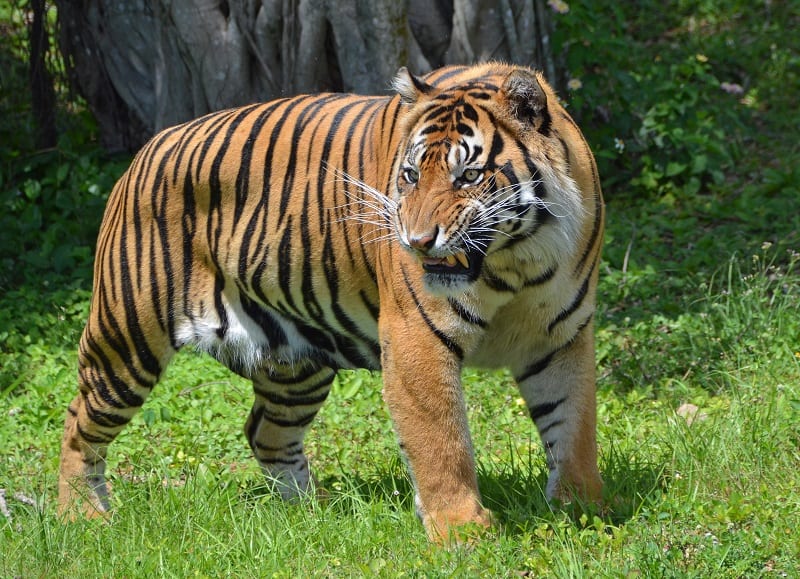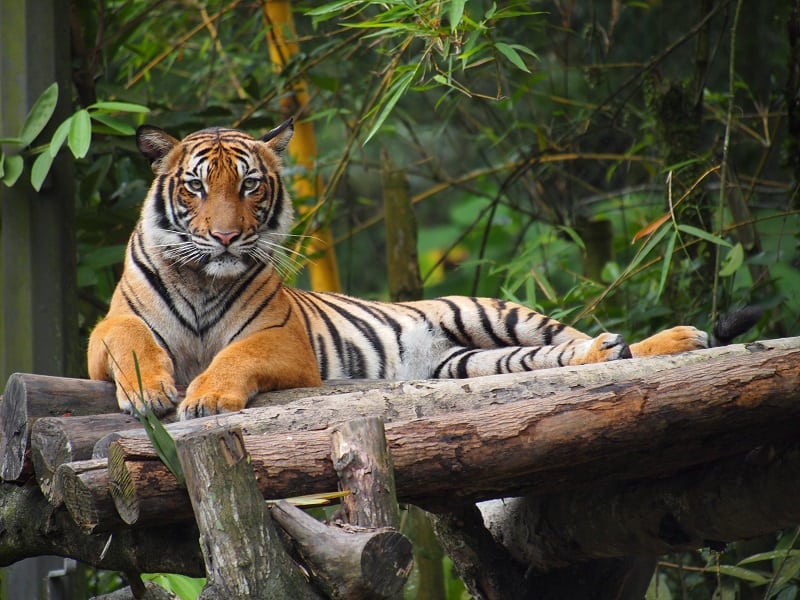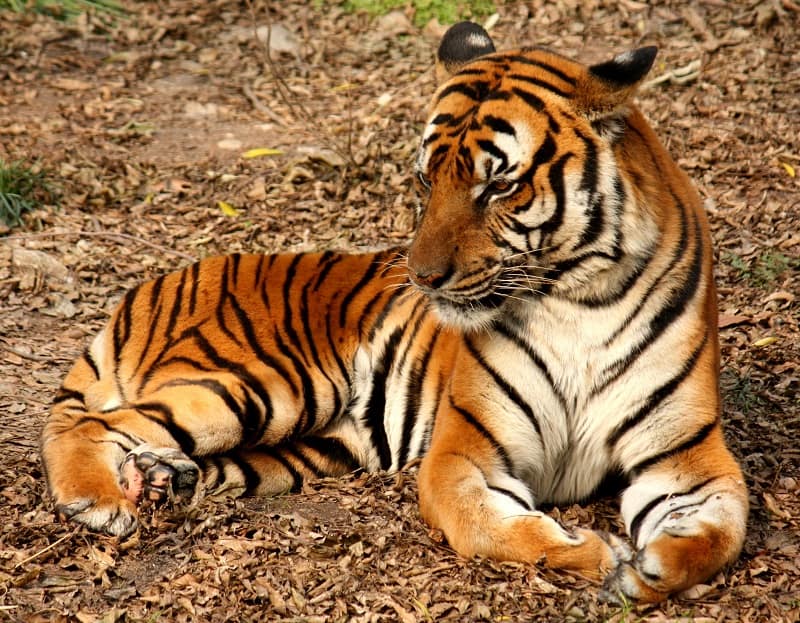Tigers are some of the coolest and most recognizable animals in the world. They’re staples at zoos around the world and have fascinated humans for centuries. However, despite the adoration, tigers are one of the most threatened species in the world. Tiger numbers have continually been in decline for decades and there are fewer than 4,000 tigers remaining in the wild. Of every documented tiger subspecies, only six remain and all of them are endangered or critically endangered. One subspecies of tiger on this list is even currently considered extinct in the wild, with few individuals in captivity. While many factors contribute to the decline of the world’s wild tiger population, the largest threat they face is from human activities, including illegal poaching, habitat loss due to human expansion, and human conflict (killing tigers because they pose a “threat”). Hopefully, raising awareness of tigers’ current circumstances can help save these majestic creatures.
Bengal Tiger

Current Estimated Population: 2,603–3,346
Location: Indian Subcontinent (Bangladesh, Nepal, and Bhutan)
Current Conservation Status: Endangered
Scientific Name: Panthera tigris tigris
When people think about tigers, they’re most likely picturing the Bengal Tiger, which is not only has the most populous tiger subspecies, but also represents all tigers. As the tiger subspecies with the highest numbers, Bengal Tigers are found at zoos and wildlife parks around the world, and even live shows in Las Vegas. If you’ve ever seen a tiger in person, it was most likely a Bengal Tiger. While there are more Bengal Tigers than the other five subspecies combined, Bengal Tigers are still endangered animals. Like all tigers, the Bengal Tiger population is in decline, primarily facing human threats, especially illegal poaching.
Siberian Tiger

Current Estimated Population: 500 to 600
Location: Russian Far East; Northeast China; and possibly North Korea
Current Conservation Status: Endangered
Scientific Name: Panthera tigris altaica
The Siberian or Amur Tiger is primarily found in the dense forests of the Russian Far East, but also lives in parts of Northeast China and possibly North Korea. In the past, the Siberian Tiger’s range was much larger and could be found throughout the Korean Peninsula, north China, and Mongolia in addition to the Russian Far East. Unfortunately, over hunting nearly decimated the wild Siberian Tiger population and its numbers have fluctuated over the years. After Russia became the first country to grant a tiger subspecies (the Siberian Tiger) full protection, its population has stabilized at more than 500, but fewer than 600.
Sumatran Tiger

Current Estimated Population: 400 to 600
Location: Sumatra, Indonesia (Sundra Islands)
Current Conservation Status: Critically Endangered
Scientific Name: Panthera tigris sumatrae or Panthera tigris sondaica
The Sumatarn Tiger is the last remaining tiger supspecies in the Sundra Islands of Indonesia, which used to also be home the Bali and Javan Tigers – the Bali Tiger went extinct in the 1950s, while the Javan Tiger was last seen in the 1980s. Sources differ, but it is estimated that there are between 400 to 600 Sumatran Tigers left in the wild. DNA analysis suggests that the Sumatran Tiger became isolated from other tiger populations after a rise in sea level that occurred between 12,000 to 6,000 years ago. Due to this, Sumatran Tigers evolved differently and have no problem living on their island home. The Sumatran Tiger population is in decline mainly because of human activity like the expansion of palm oil plantations.
Indochinese Tiger

Current Estimated Population: about 350
Location: Myanmar; Thailand; Laos; Vietnam; Cambodia; and southwestern China (probably extinct in this area)
Current Conservation Status: Endangered
Scientific Name: Panthera tigris corbetti
The Indochinese Tiger is native to Myanmar, Thailand, Laos, Vietnam, Cambodia, and southwestern China. However, scientists believe that the Indochinese Tiger may be extinct in China as no individuals have been seen in the area in recent years. Research also suggests that there might not be any breeding Indochinese Tigers left in Cambodia and Vietnam as well. Although all tigers are fairly mysterious, the Indochinese Tiger is solitary and very elusive, so little is known of the animal’s behavior in the wild. Of all the remaining tiger subspecies, Indochinese Tigers are the least represented in the captive population. Since the Malayan Tiger was split off into its own subspecies in 2004, there are less than a handful of Indochinese Tigers in zoos around the world.
Malayan Tiger

Current Estimated Population: 250 to 340
Location: Southern and central parts of the Malay Peninsula; southern tip of Thailand
Current Conservation Status: Critically Endangered
Scientific Name: Panthera tigris jacksoni
Until 2004, the Malayan Tiger was classified as the same species as the Indochina Tiger. However, following a genetic analysis, it was determined that the Malayan Tiger was its own subspecies and it was dubbed the Panthera tigris jacksoni, in honor of Peter Jackson, a famed tiger conservationists (not the famous film director). As its name suggests, the Malayan Tiger is primarily found in the southern and central parts of the Malay Peninsula. There is also a small population of Malayan Tigers in the southern tip of Thailand. The biggest threat to the Malayan Tiger population is excessive logging and road construction.
South China Tiger

Current Estimated Population: functionally extinct in the wild, but about 100 or so in captivity
Location: Southeast China – mostly in Hainan Moist Forests
Current Conservation Status: Critically Endangered
Scientific Name: Panthera tigris amoyensis
The South China Tiger has been declared “functionally extinct” in the wild by scientists, which makes it the rarest tiger species in the world. While the South China Tiger has not been seen in the wild for more than 25 years, there are about 100 tigers in captivity and breeding programs have been ongoing. It was previously thought that the captive population of South China Tigers was too small and lacked enough genetic diversity, but since the start of a centrally registered studbook a few years ago, there is some hope that the South China Tiger could be re-introduced into the wild in the future. In the early 1950s, it was estimated that there were about 4,000 wild South China Tigers, but those numbers drastically dropped with a few decades. Thousands of South China Tigers were killed for being “pests” and more died because of habitat degradation.
This article originally appeared on Rarest.org.
More from Rarest.org
12 Rarest Ferrari Cars Ever

Few automotive brands evoke the same level of passion and reverence as Ferrari, renowned for its iconic design, unparalleled performance, and storied racing pedigree. Within Ferrari’s illustrious history lie a select few models that stand out as the rarest and most coveted among collectors and enthusiasts. Read More
1934 Buffalo Nickel Value Guide

Except for the reverse, the Type II Buffalo nickel replicates the Type I of 1913. If you check the coin’s reverse, the bottom portion has been redesigned on the Type II. Read More
1996 Washington Quarter Value Guide

The 1996 quarter is an interesting coin regarding history, value, and composition. Thus, it is not surprising that some people are interested in adding this coin to their collection. Read More
